以下翻译基于:
下面开始:
conversion between grid and screen
As I mentioned in comment you should make functions that convert between screen and cell grid positions. something like (in C++):
const int cxs=100;
const int cys= 50;
const int czs= 15;
const int cxs2=cxs>>1;
const int cys2=cys>>1;
int pan_x=0,pan_y=0;
void isometric::cell2scr(int &sx,int &sy,int cx,int cy,int cz)
{
sx=pan_x+(cxs*cx)+((cy&1)*cxs2);
sy=pan_y+(cys*cy/2)-(czs*cz);
}
void isometric::scr2cell(int &cx,int &cy,int &cz,int sx,int sy)
{
cy=(2*(sy-pan_y))/cys;
cx= (sx-pan_x-((cy&1)*cxs2))/cxs;
cz=0;
int xx,yy;
cell2scr(xx,yy,cx,cy,cz);
xx=sx-xx; mx0=cx;
yy=sy-yy; my0=cy;
if (xx<=cxs2) { if (yy> xx *cys/cxs) { cy++; if (int(cy&1)!=0) cx--; } }
else { if (yy>(cxs-xx)*cys/cxs) { cy++; if (int(cy&1)==0) cx++; } }
}
I used your layout (took mi while to convert mine to it hopefully I do not made some silly mistake somewhere):
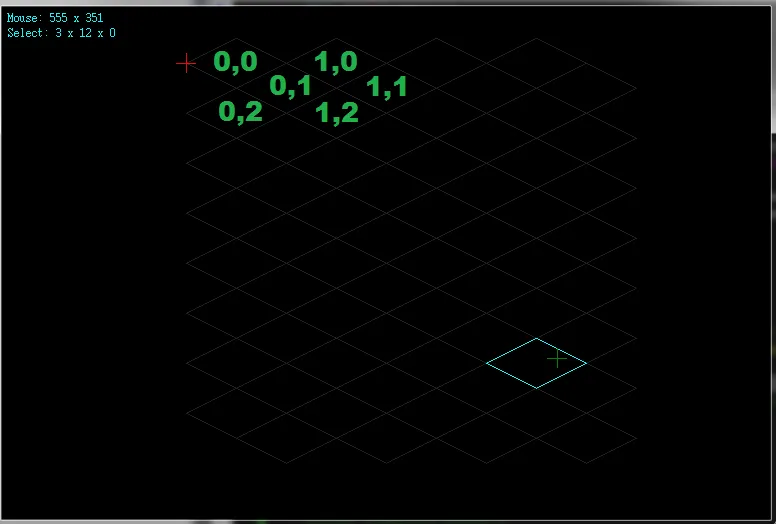
- red cross represents coordinates returned by
cell2scr(x,y,0,0,0)
- green cross represents mouse coordinates
- aqua highlight represents returned cell position
Beware if you are using integer arithmetics you need to take in mind if you dividing/multiplying by half sizes you can lose precision. Use full size and divide the result by 2 for such cases (spend a lot of time figuring that one out in the past).
The cell2scr is pretty straightforward. The screen position is pan offset + cell position multiplied by its size (step). The x axis need a correction for even/odd rows (that is what ((cy&1)*cxs2) is for) and y axis is shifted by the z axis (((cy&1)*cxs2)). Mine screen has point (0,0) in upper left corner, +x axis is pointing right and +y is pointing down.
The scr2cell is done by algebraically solved screen position from the equations of cell2scr while assuming z=0 so selects only the grid ground. On top of that is just the even/odd correction added if mouse position is outside found cell area.
scan neighbors
the scr2cell(x,y,z,mouse_x,mouse_y) returns just cell where your mouse is on the ground. so if you want to add your current selection functionality you need to scan the top cell on that position and few neighboring cells and select the one with least distance.
No need to scan the whole grid/map just few cells around returned position. That should speed up thing considerably.
I do it like this:

The number of lines depends on the cell z axis size (czs), max number of z layers (gzs) and the cell size (cys). The C++ code of mine with scan looks like this:
const int gxs=15;
const int gys=30;
const int gzs=8;
int map[gzs][gys][gxs];
void isometric::scr2cell(int &cx,int &cy,int &cz,int sx,int sy)
{
cy=(2*(sy-pan_y))/cys;
cx= (sx-pan_x-((cy&1)*cxs2))/cxs;
cz=0;
int xx,yy;
cell2scr(xx,yy,cx,cy,cz);
xx=sx-xx;
yy=sy-yy;
if (xx<=cxs2) { if (yy> xx *cys/cxs) { cy++; if (int(cy&1)!=0) cx--; } }
else { if (yy>(cxs-xx)*cys/cxs) { cy++; if (int(cy&1)==0) cx++; } }
int x0=-1,y0=-1,z0=-1,a,b,i;
#define _scann \
if ((cx>=0)&&(cx<gxs)) \
if ((cy>=0)&&(cy<gys)) \
{ \
for (cz=0;(map[cz+1][cy][cx]!=_cell_type_empty)&&(cz<czs-1);cz++); \
cell2scr(xx,yy,cx,cy,cz); \
if (map[cz][cy][cx]==_cell_type_full) yy-=czs; \
xx=(sx-xx); yy=((sy-yy)*cxs)/cys; \
a=(xx+yy); b=(xx-yy); \
if ((a>=0)&&(a<=cxs)&&(b>=0)&&(b<=cxs)) \
if (cz>=z0) { x0=cx; y0=cy; z0=cz; } \
}
_scann;
for (i=gzs*czs;i>=0;i-=cys)
{
cy++; if (int(cy&1)!=0) cx--; _scann;
cx++; _scann;
cy++; if (int(cy&1)!=0) cx--; _scann;
}
cx=x0; cy=y0; cz=z0;
#undef _scann
}
This selects always the top cell (highest from all the possible) when playing with mouse it feels correctly (at least to me):
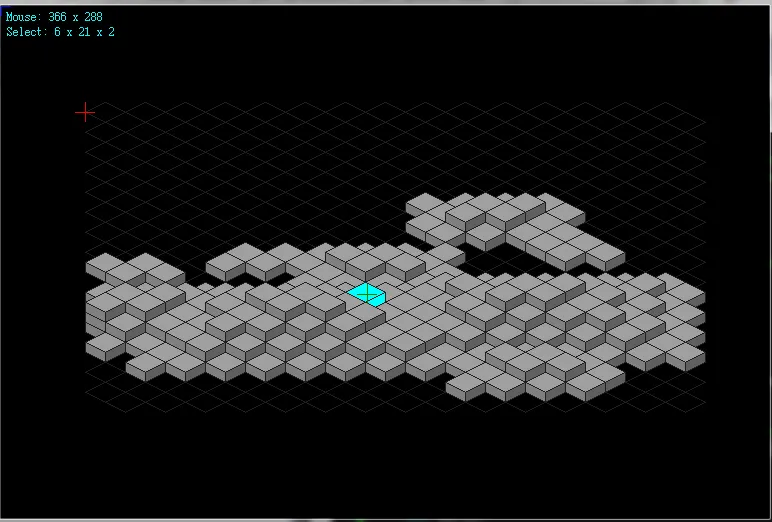
这是我今天为我的等角引擎破解的完整VCL/C++源代码:
#ifndef _isometric_h
#define _isometric_h
DWORD col_back =0x00000000;
DWORD col_grid =0x00202020;
DWORD col_xside=0x00606060;
DWORD col_yside=0x00808080;
DWORD col_zside=0x00A0A0A0;
DWORD col_sel =0x00FFFF00;
#define isometric_layout_2
const int gxs=15;
const int gys=30;
const int gzs=8;
const int cxs=40;
const int cys=20;
const int czs=10;
const int cxs2=cxs>>1;
const int cys2=cys>>1;
enum _cell_type_enum
{
_cell_type_empty=0,
_cell_type_ground,
_cell_type_full,
_cell_types
};
class isometric
{
public:
Graphics::TBitmap *bmp;
DWORD **pyx;
int xs,ys;
int map[gzs][gys][gxs];
int mx,my,mx0,my0;
TShiftState sh,sh0;
int sel_x,sel_y,sel_z;
int pan_x,pan_y;
isometric();
isometric(isometric& a) { *this=a; }
~isometric();
isometric* operator = (const isometric *a) { *this=*a; return this; }
isometric* operator = (const isometric &a);
void resize(int _xs,int _ys);
void mouse(int x,int y,TShiftState sh);
void draw();
void cell2scr(int &sx,int &sy,int cx,int cy,int cz);
void scr2cell(int &cx,int &cy,int &cz,int sx,int sy);
void cell_draw(int x,int y,int tp,bool _sel=false);
void map_random();
};
isometric::isometric()
{
bmp=new Graphics::TBitmap;
bmp->HandleType=bmDIB;
bmp->PixelFormat=pf32bit;
pyx=NULL; xs=0; ys=0;
resize(1,1);
int x,y,z,t;
t=_cell_type_empty;
for (z=0;z<gzs;z++,t=_cell_type_empty)
for (y=0;y<gys;y++)
for (x=0;x<gxs;x++)
map[z][y][x]=t;
mx =0; my =0; sh =TShiftState();
mx0=0; my0=0; sh0=TShiftState();
sel_x=-1; sel_y=-1; sel_z=-1;
pan_x=0; pan_y=0;
}
isometric::~isometric()
{
if (pyx) delete[] pyx; pyx=NULL;
if (bmp) delete bmp; bmp=NULL;
}
isometric* isometric::operator = (const isometric &a)
{
resize(a.xs,a.ys);
bmp->Canvas->Draw(0,0,a.bmp);
int x,y,z;
for (z=0;z<gzs;z++)
for (y=0;y<gys;y++)
for (x=0;x<gxs;x++)
map[z][y][x]=a.map[z][y][x];
mx=a.mx; mx0=a.mx0; sel_x=a.sel_x;
my=a.my; my0=a.my0; sel_y=a.sel_y;
sh=a.sh; sh0=a.sh0; sel_z=a.sel_z;
pan_x=a.pan_x;
pan_y=a.pan_y;
return this;
}
void isometric::resize(int _xs,int _ys)
{
if (_xs<1) _xs=1;
if (_ys<1) _ys=1;
if ((xs==_xs)&&(ys==_ys)) return;
bmp->SetSize(_xs,_ys);
xs=bmp->Width;
ys=bmp->Height;
if (pyx) delete pyx;
pyx=new DWORD*[ys];
for (int y=0;y<ys;y++) pyx[y]=(DWORD*) bmp->ScanLine[y];
cell2scr(pan_x,pan_y,gxs>>1,gys>>1,0);
pan_x=(xs>>1)-pan_x;
pan_y=(ys>>1)-pan_y;
}
void isometric::mouse(int x,int y,TShiftState shift)
{
mx0=mx; mx=x;
my0=my; my=y;
sh0=sh; sh=shift;
scr2cell(sel_x,sel_y,sel_z,mx,my);
if ((sel_x<0)||(sel_y<0)||(sel_z<0)||(sel_x>=gxs)||(sel_y>=gys)||(sel_z>=gzs)) { sel_x=-1; sel_y=-1; sel_z=-1; }
}
void isometric::draw()
{
int x,y,z,xx,yy;
bmp->Canvas->Brush->Color=col_back;
bmp->Canvas->FillRect(TRect(0,0,xs,ys));
DWORD c0=col_zside;
col_zside=col_back;
for (y=0;y<gys;y++)
for (x=0;x<gxs;x++)
{
cell2scr(xx,yy,x,y,0);
cell_draw(xx,yy,_cell_type_ground,false);
}
col_zside=c0;
for (z=0;z<gzs;z++)
for (y=0;y<gys;y++)
for (x=0;x<gxs;x++)
{
cell2scr(xx,yy,x,y,z);
cell_draw(xx,yy,map[z][y][x],(x==sel_x)&&(y==sel_y)&&(z==sel_z));
}
bmp->Canvas->Pen->Color=clBlue;
bmp->Canvas->MoveTo(mx0-10,my0); bmp->Canvas->LineTo(mx0+10,my0);
bmp->Canvas->MoveTo(mx0,my0-10); bmp->Canvas->LineTo(mx0,my0+10);
bmp->Canvas->Pen->Color=clGreen;
bmp->Canvas->MoveTo(mx-10,my); bmp->Canvas->LineTo(mx+10,my);
bmp->Canvas->MoveTo(mx,my-10); bmp->Canvas->LineTo(mx,my+10);
bmp->Canvas->Pen->Color=clRed;
bmp->Canvas->MoveTo(pan_x-10,pan_y); bmp->Canvas->LineTo(pan_x+10,pan_y);
bmp->Canvas->MoveTo(pan_x,pan_y-10); bmp->Canvas->LineTo(pan_x,pan_y+10);
bmp->Canvas->Font->Charset=OEM_CHARSET;
bmp->Canvas->Font->Name="System";
bmp->Canvas->Font->Pitch=fpFixed;
bmp->Canvas->Font->Color=clAqua;
bmp->Canvas->Brush->Style=bsClear;
bmp->Canvas->TextOutA(5, 5,AnsiString().sprintf("Mouse: %i x %i",mx,my));
bmp->Canvas->TextOutA(5,20,AnsiString().sprintf("Select: %i x %i x %i",sel_x,sel_y,sel_z));
bmp->Canvas->Brush->Style=bsSolid;
}
void isometric::cell2scr(int &sx,int &sy,int cx,int cy,int cz)
{
#ifdef isometric_layout_1
sx=pan_x+((cxs*(cx-cy))/2);
sy=pan_y+((cys*(cx+cy))/2)-(czs*cz);
#endif
#ifdef isometric_layout_2
sx=pan_x+(cxs*cx)+((cy&1)*cxs2);
sy=pan_y+(cys*cy/2)-(czs*cz);
#endif
}
void isometric::scr2cell(int &cx,int &cy,int &cz,int sx,int sy)
{
int x0=-1,y0=-1,z0=-1,a,b,i,xx,yy;
#ifdef isometric_layout_1
xx=sx-pan_x-cxs2;
yy=sy-pan_y+cys2;
yy=(yy*cxs)/cys;
cx=(+xx+yy)/cxs;
cy=(-xx+yy)/cxs;
cz=0;
#define _scann \
if ((cx>=0)&&(cx<gxs)) \
if ((cy>=0)&&(cy<gys)) \
{ \
for (cz=0;(map[cz+1][cy][cx]!=_cell_type_empty)&&(cz<czs-1);cz++); \
cell2scr(xx,yy,cx,cy,cz); \
if (map[cz][cy][cx]==_cell_type_full) yy-=czs; \
xx=(sx-xx); yy=((sy-yy)*cxs)/cys; \
a=(xx+yy); b=(xx-yy); \
if ((a>=0)&&(a<=cxs)&&(b>=0)&&(b<=cxs)) \
if (cz>=z0) { x0=cx; y0=cy; z0=cz; } \
}
_scann;
for (i=gzs*czs;i>=0;i-=cys)
{
cy++; _scann;
cx++; cy--; _scann;
cy++; _scann;
}
cx=x0; cy=y0; cz=z0;
#undef _scann
#endif
#ifdef isometric_layout_2
cy=(2*(sy-pan_y))/cys;
cx= (sx-pan_x-((cy&1)*cxs2))/cxs;
cz=0;
cell2scr(xx,yy,cx,cy,cz);
xx=sx-xx;
yy=sy-yy;
if (xx<=cxs2) { if (yy> xx *cys/cxs) { cy++; if (int(cy&1)!=0) cx--; } }
else { if (yy>(cxs-xx)*cys/cxs) { cy++; if (int(cy&1)==0) cx++; } }
#define _scann \
if ((cx>=0)&&(cx<gxs)) \
if ((cy>=0)&&(cy<gys)) \
{ \
for (cz=0;(map[cz+1][cy][cx]!=_cell_type_empty)&&(cz<czs-1);cz++); \
cell2scr(xx,yy,cx,cy,cz); \
if (map[cz][cy][cx]==_cell_type_full) yy-=czs; \
xx=(sx-xx); yy=((sy-yy)*cxs)/cys; \
a=(xx+yy); b=(xx-yy); \
if ((a>=0)&&(a<=cxs)&&(b>=0)&&(b<=cxs)) \
if (cz>=z0) { x0=cx; y0=cy; z0=cz; } \
}
_scann;
for (i=gzs*czs;i>=0;i-=cys)
{
cy++; if (int(cy&1)!=0) cx--; _scann;
cx++; _scann;
cy++; if (int(cy&1)!=0) cx--; _scann;
}
cx=x0; cy=y0; cz=z0;
#undef _scann
#endif
}
void isometric::cell_draw(int x,int y,int tp,bool _sel)
{
TPoint pnt[5];
bmp->Canvas->Pen->Color=col_grid;
if (tp==_cell_type_empty)
{
if (!_sel) return;
bmp->Canvas->Pen->Color=col_sel;
pnt[0].x=x; pnt[0].y=y ;
pnt[1].x=x+cxs2; pnt[1].y=y+cys2;
pnt[2].x=x+cxs; pnt[2].y=y ;
pnt[3].x=x+cxs2; pnt[3].y=y-cys2;
pnt[4].x=x; pnt[4].y=y ;
bmp->Canvas->Polyline(pnt,4);
}
else if (tp==_cell_type_ground)
{
if (_sel) bmp->Canvas->Brush->Color=col_sel;
else bmp->Canvas->Brush->Color=col_zside;
pnt[0].x=x; pnt[0].y=y ;
pnt[1].x=x+cxs2; pnt[1].y=y+cys2;
pnt[2].x=x+cxs; pnt[2].y=y ;
pnt[3].x=x+cxs2; pnt[3].y=y-cys2;
bmp->Canvas->Polygon(pnt,3);
}
else if (tp==_cell_type_full)
{
if (_sel) bmp->Canvas->Brush->Color=col_sel;
else bmp->Canvas->Brush->Color=col_xside;
pnt[0].x=x+cxs2; pnt[0].y=y+cys2;
pnt[1].x=x+cxs; pnt[1].y=y;
pnt[2].x=x+cxs; pnt[2].y=y -czs;
pnt[3].x=x+cxs2; pnt[3].y=y+cys2-czs;
bmp->Canvas->Polygon(pnt,3);
if (_sel) bmp->Canvas->Brush->Color=col_sel;
else bmp->Canvas->Brush->Color=col_yside;
pnt[0].x=x; pnt[0].y=y;
pnt[1].x=x+cxs2; pnt[1].y=y+cys2;
pnt[2].x=x+cxs2; pnt[2].y=y+cys2-czs;
pnt[3].x=x; pnt[3].y=y -czs;
bmp->Canvas->Polygon(pnt,3);
if (_sel) bmp->Canvas->Brush->Color=col_sel;
else bmp->Canvas->Brush->Color=col_zside;
pnt[0].x=x; pnt[0].y=y -czs;
pnt[1].x=x+cxs2; pnt[1].y=y+cys2-czs;
pnt[2].x=x+cxs; pnt[2].y=y -czs;
pnt[3].x=x+cxs2; pnt[3].y=y-cys2-czs;
bmp->Canvas->Polygon(pnt,3);
}
}
void isometric::map_random()
{
int i,x,y,z,x0,y0,r,h;
for (z=0;z<gzs;z++)
for (y=0;y<gys;y++)
for (x=0;x<gxs;x++)
map[z][y][x]=_cell_type_empty;
Randomize();
for (i=0;i<10;i++)
{
x0=Random(gxs);
y0=Random(gys);
r=Random((gxs+gys)>>3)+1;
h=Random(gzs);
for (z=0;(z<gzs)&&(r);z++,r--)
for (y=y0-r;y<y0+r;y++)
if ((y>=0)&&(y<gys))
for (x=x0-r;x<x0+r;x++)
if ((x>=0)&&(x<gxs))
map[z][y][x]=_cell_type_full;
}
}
#endif
布局仅定义坐标轴的方向(请使用
#define isometric_layout_2)。这里使用
Graphics::TBitmap,如果您不使用,请将其更改为任何位图或覆盖gfx部分以使用您的gfx(仅对
draw()和
resize()有效)。此外,
TShiftState是的一部分,它只是鼠标按钮和特殊键(如
shift、
alt、
ctrl)的状态,因此您可以使用
bool或其他替代方法(目前未使用,因为我还没有任何单击功能)。
这是我的窗口代码(一个带有一个计时器的单表应用程序),这样您就可以了解如何使用它:
#include <vcl.h>
#pragma hdrstop
#include "win_main.h"
#include "isometric.h"
#pragma package(smart_init)
#pragma resource "*.dfm"
TMain *Main;
isometric iso;
void TMain::draw()
{
iso.draw();
Canvas->Draw(0,0,iso.bmp);
}
__fastcall TMain::TMain(TComponent* Owner) : TForm(Owner)
{
Cursor=crNone;
iso.map_random();
}
void __fastcall TMain::FormResize(TObject *Sender)
{
iso.resize(ClientWidth,ClientHeight);
draw();
}
void __fastcall TMain::FormPaint(TObject *Sender)
{
draw();
}
void __fastcall TMain::tim_redrawTimer(TObject *Sender)
{
draw();
}
void __fastcall TMain::FormMouseMove(TObject *Sender, TShiftState Shift, int X,int Y) { iso.mouse(X,Y,Shift); draw(); }
void __fastcall TMain::FormMouseDown(TObject *Sender, TMouseButton Button,TShiftState Shift, int X, int Y) { iso.mouse(X,Y,Shift); draw(); }
void __fastcall TMain::FormMouseUp(TObject *Sender, TMouseButton Button,TShiftState Shift, int X, int Y) { iso.mouse(X,Y,Shift); draw(); }
void __fastcall TMain::FormDblClick(TObject *Sender)
{
iso.map_random();
}
[编辑1] 图形处理方法
请查看Simple OpenGL GUI Framework User Interaction Advice?。
主要思路是创建一个阴影屏幕缓冲区,其中存储了渲染单元的ID。这只需要几行代码就可以实现在O(1)时间内进行像素级别的精确精灵/单元选择。
create shadow screen buffer idx[ys][xs]
It should have the same resolution as your map view And should be capable of storing the (x,y,z) value of render cell inside single pixel (in map grid cell units). I use 32 bit pixel format so I choose 12 bits for x,y and 8 bits for z
DWORD color = (x) | (y<<12) | (z<<24)
before rendering of map clear this buffer
I use 0xFFFFFFFF as empty color so it is not colliding with cell (0,0,0).
on map cell sprite rendering
whenever you render pixel to screen buffer pyx[y][x]=color you also render pixel to shadow screen buffer idx[y][x]=c where c is encoded cell position in map grid units (see #1).
On mouse click (or whatever)
You got screen position of mouse mx,my so if it is in range just read the shadow buffer and obtain selected cell position.
c=idx[my][mx]
if (c!=0xFFFFFFFF)
{
x= c &0x00000FFF;
y=(c>>12)&0x00000FFF;
z=(c>>24)&0x000000FF;
}
else
{
}
With above encoding this map (screen):
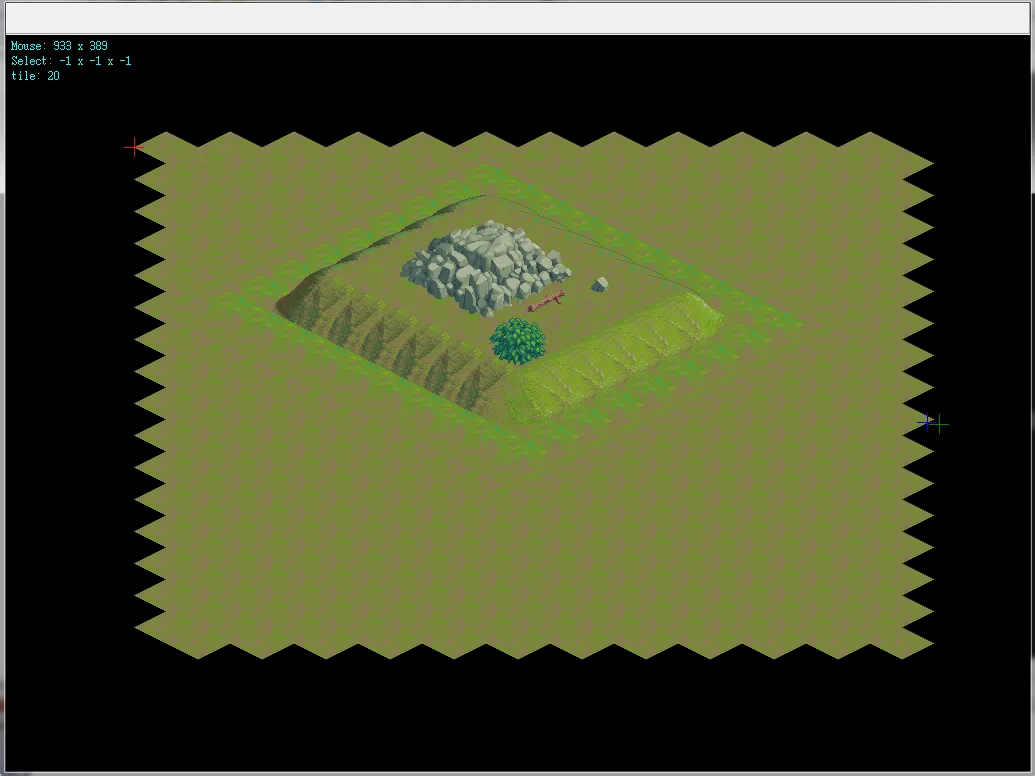
is rendered also to shadow screen like this:
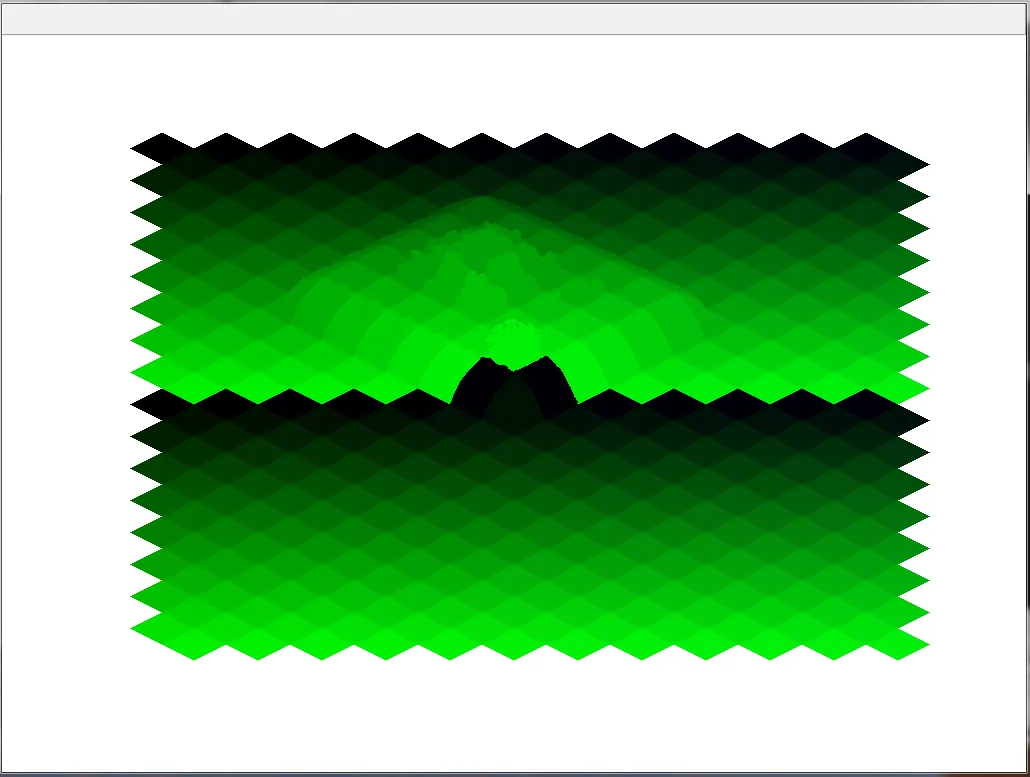
Selection is pixel perfect does not matter if you click on top, side...
The tiles used are:
Title: Isometric 64x64 Outside Tileset
Author: Yar
URL: http://opengameart.org/content/isometric-64x64-outside-tileset
License(s): * CC-BY 3.0 http://creativecommons.org/licenses/by/3.0/legalcode
And here Win32 Demo:

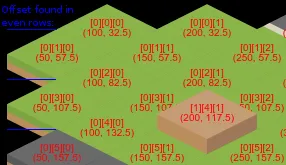









Y,Z轴。 - Spektre